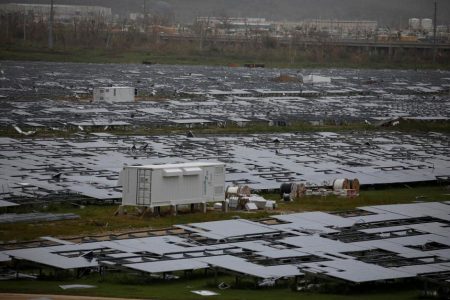SAN JUAN, Puerto Rico/NEW YORK, (Reuters) – Broken electricity poles and streetlights list into the middle of highways. Satellite images show an island devoid of light. Cellular phone service is non-existent.
Hurricane Maria’s devastation of the U.S. territory of Puerto Rico last week left the entire island and its 3.4 million residents without power.
Officials are still evaluating what is needed to kick off a months-long effort to bring back electricity, meaning millions of people could face an extended period without clean water, refrigeration, safe food or medical supplies.

A full damage assessment by Puerto Rico Electric Power Authority (PREPA) has been difficult because of the limited ability to get flights to the island and federal agencies concentrating on saving lives and providing power to crucial infrastructure like hospitals.
“They should be complete with their initial damage assessment in days or maybe a week – not weeks or months,” said Gil Quiniones, president of New York Power Authority (NYPA), who traveled with New York State Governor Andrew Cuomo to the island on Friday.
Quiniones, who took a team of 10 from the state-owned NYPA with him, said power generation damage has been minimal, but transmission and distribution lines have been hit with “extensive” damage. Fixing those lines will be an extended process, so many will be relying on diesel and gasoline during that time.
Maria struck Puerto Rico as a very dangerous Category 4 hurricane on Wednesday, with winds up to 155 miles per hour (249 km per hour), leveling structures across large swathes of the island, killing at least 10 residents and cutting off power and telecommunications services.
Highway signs and traffic poles were scattered across highways around the island on Tuesday, with intersections turned into obstacle courses as cars drove over and around tangled wires and other debris. Broken transmission towers – heavy steel structures up to 150 feet (46 meters) tall that support high-voltage wires – were visible.
Unlike Hurricane Irma a week earlier, where tens of thousands of utility workers streamed into Florida shortly after that storm swept through the state, those determining the extent of the damage to Puerto Rico’s degraded electrical grid were only starting to get the full measure of the destruction.
Rebuilding will be a challenging task for PREPA, which declared bankruptcy in July and is regularly criticized by residents for frequent outages and rates higher than every U.S. state other than Hawaii.
About 55 percent of the island’s transmission towers have been destroyed, according to industry group the American Public Power Association (APPA), which is working with the U.S. Federal Emergency Management Agency on relief efforts.
About 90 percent of the distribution network, which brings power to residents and businesses, is out of commission, APPA said. Nighttime satellite images released by the U.S. National Oceanic and Atmospheric Administration showed the island early on Monday almost entirely without light.
The U.S. Federal Communications Commission said on Monday that 91 percent of cellular sites in Puerto Rico remain out of service. Outside San Juan, the capital, cell service was virtually non-existent, and residents said they have been unable to communicate with relatives and friends, be they distant or merely just in another part of the island.
Quiniones said it was difficult to send assistance teams of utility workers that usually swarm into a region hit by bad weather because Puerto Rico is an island.
At the moment, NYPA is not sending additional people beyond those helping to appraise the damages. Quiniones said PREPA needed first to work out what resources it needed to rebuild the grid. “They need to complete the damage assessment first,” he said. “They have to be able to plan and prioritize the work.”
The rates PREPA charges were not enough for the utility to maintain its infrastructure, in part due to ineffective collection efforts, and long-standing mismanagement that had left it in a $9-billion hole before declaring bankruptcy in July this year.
“The country is likely going to be without power for months,” said Ismael Perez, an engineer and resident. The national utility needs to be depoliticized or privatized, he said.
PREPA’s equipment was already “degraded and unsafe,” according to a draft fiscal report the utility filed in April.
The collapse of power could in fact accelerate PREPA’s restructuring effort, a source familiar with the bankruptcy said, as it would put the system on a more stable footing.
The damage would motivate creditors to resolve the bankruptcy due to investments needed to restore power, said Matt Fabian, municipal debt analyst at MMA Inc: “It doesn’t make a lot of sense to spend a billion dollars restoring damaged generation facilities that are about to be replaced.”





